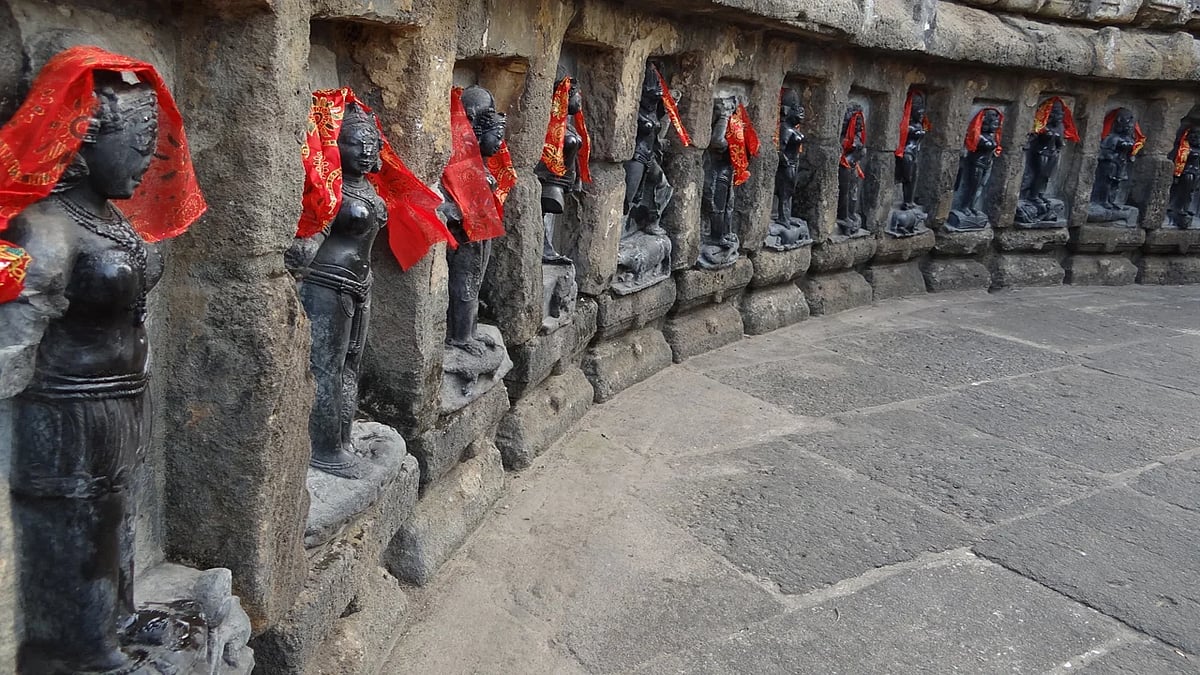**Chausath Yogini Temples of Madhya Pradesh: A Mystical Legacy Now on UNESCO’s Tentative List**
*Bhopal (Madhya Pradesh):*
Nestled in the heart of India, a remarkable set of historical and spiritual structures—steeped in tales told through intricate wall carvings, embodying divine architectural elements, and radiating feminine power—has been added to UNESCO’s tentative list. These are the **Chausath Yogini Temples** of Madhya Pradesh, dating back to the 9th century. They stand as witnesses to unique Hindu spiritual and tantric rituals performed by 64 powerful female deities.
### The Divine Legacy of the Yoginis
The 64 Yoginis depicted in these temples are considered different manifestations of **Goddess Durga**, the fierce warrior who fought the demons Shumbha and Nishumbha. Revered as female attendants of Lord Shiva, these Yoginis embody divine feminine power and represent an esoteric spiritual tradition.
### Temples Full of Secrets
Chausath Yogini Temples are not just historical monuments; they are spiritual hubs filled with untold tales. The rituals performed here blend ancient and living traditions, involving ritual worship, festival celebrations, and secretive tantric rites that have survived the ages.
### Concentration in Madhya Pradesh: 8 out of 13 Temples
Across India, only about 13 Chausath Yogini Temples still stand, with 8 located in Madhya Pradesh. These remarkable structures are attracting historians, devotees, and tourists alike, standing as powerful reminders of India’s profound spiritual heritage and unique architectural styles.
### Unique Architectural Style: Circular Temples with Open Roofs
Unlike the typical rectangular or square layouts commonly found in Indian temples, Chausath Yogini Temples are characteristically circular—or occasionally rectangular—but always **open to the sky** (hypaethral).
This distinctive open-air design symbolizes the cosmic cycle and allows direct communion with nature and the elements, reflecting the tantric principles central to Yogini worship.
The temples feature an inner circumference lined with **64 small chambers or niches**, each originally housing a Yogini idol. These shrines form an unbroken circle around a central open courtyard, emphasizing the collective strength of the Yoginis and their pivotal role in tantric rituals.
At the center stands a larger shrine, usually dedicated to Shiva or Shakti, visible from every Yogini cell. This symbolizes the union of divine masculine and feminine energies.
### Origins and Builders
Chausath Yogini Temples were constructed primarily between the 9th and 12th centuries by dynasties such as the **Chandelas, Kalachuris, and Kachchhapaghatas**. While these temples are mainly found in Madhya Pradesh and Odisha today, their spiritual and cultural impact extends far beyond.
### What Makes These Temples Special?
The temples are associated with an esoteric cult celebrating feminine power and challenging orthodox norms, making them unique cultural treasures.
Among the 13 temples, the two most renowned are:
– **The 11th-century Mitawali Temple** in Madhya Pradesh’s Morena, built by King Devapala.
– **The 9th-century Hirapur Temple** in Odisha, likely built by Queen Hiradevi of the Bhouma dynasty.
### Unique Forms of Worship
Historically, Chausath Yogini Temples have been centers for esoteric and spiritual practices, quite distinct from mainstream Hindu rituals.
Key practices include:
– **Tantric Worship:** Secret rites such as *prana pratishtha* (image consecration), Yogini Puja, purification rituals, and the creation of mystical yantras, often involving symbolic items like areca nuts.
– **Daily & Seasonal Offerings:** Regular offerings of fruits, incense, and light, with elaborate rituals on festivals such as Holi and during the autumn season.
– **Kaula Chakra & Five Ms Rituals:** Transgressive tantric ceremonies involving Matsya (fish), Mamsa (meat), Mudra (gesture or parched grain), Madya (alcohol), and Maithuna (ritual union) — all bearing profound spiritual symbolism.
– **Chausath Yogini Mahotsav:** A modern 3-day festival held at Hirapur (Odisha), featuring tantric rituals, elemental worship, yoga sessions, cultural performances, and community celebrations.
– **Mantra Japa & Yagna:** Multi-day events involving mantra chanting, deity invocations, sacred pot installations, and powerful yantra worship aimed at peace and protection.
### Locations of Chausath Yogini Temples
These temples are predominantly found in Central India, especially Madhya Pradesh, but also in Odisha, Uttar Pradesh, and Tamil Nadu.
#### Notable Sites Include:
– **Madhya Pradesh:**
Home to 8 temples, including the famous Khajuraho (the oldest), Mitaoli (noted for its circular design and links to the Indian Parliament), Jabalpur (a hilltop site featuring 81 shrines), Badoh, Hinglajgarh, Shahdol, and now-lost sites at Naresar.
– **Uttar Pradesh:**
Temples at Lokhari, Dudhai, and Rikhiyan.
– **Odisha:**
Well-preserved temples at Hirapur and Ranipur Jharial, both known for their open-sky circular architecture.
– **Tamil Nadu:**
A lesser-known site at Kanchipuram.
### Best Time to Visit
The ideal months to explore Chausath Yogini Temples—whether in Jabalpur, Khajuraho or Hirapur—are from **October to March**, when the weather is mild (10°C to 28°C), perfect for sightseeing and climbing.
– **Jabalpur:** October to March; early mornings or late afternoons are best. Mahashivratri brings vibrant cultural celebrations but also larger crowds.
– **Khajuraho:** Best from November to February, especially during the Khajuraho Dance Festival.
– **Hirapur:** October to March offers pleasant weather; early mornings ensure a peaceful experience.
### Seasonal Notes
Visiting during the monsoon season brings lush green surroundings but travel can be challenging due to rain and humidity.
—
The Chausath Yogini Temples of Madhya Pradesh represent a priceless spiritual and architectural heritage that continues to inspire awe. Their inclusion on UNESCO’s tentative list underscores their outstanding value and invites the world to appreciate the enduring legacy of feminine divine power and tantric traditions in India.
https://www.freepressjournal.in/bhopal/navratri-special-explore-chausath-yogini-the-epicentre-of-divine-feminine-power-secret-tantric-rituals-performed-by-lord-shivas-yoginins

